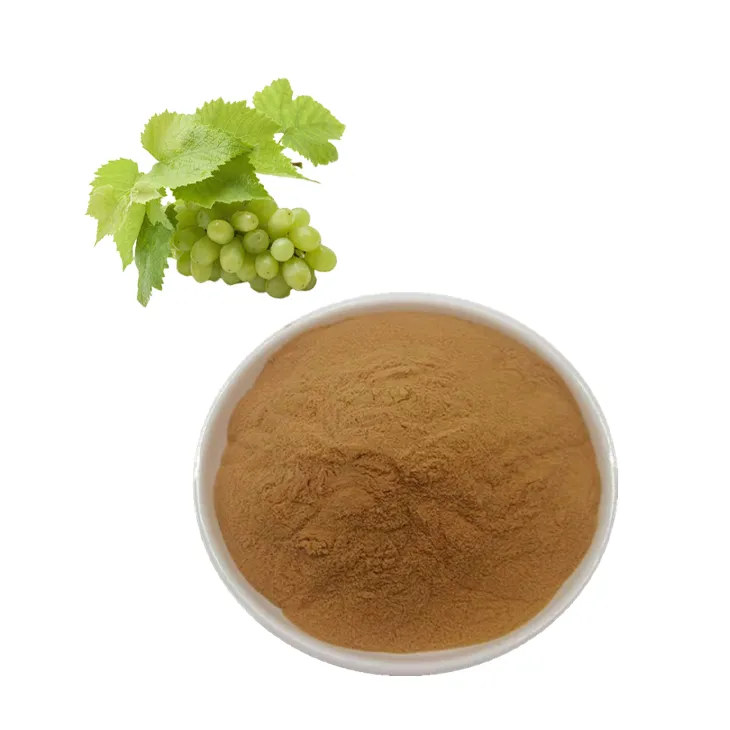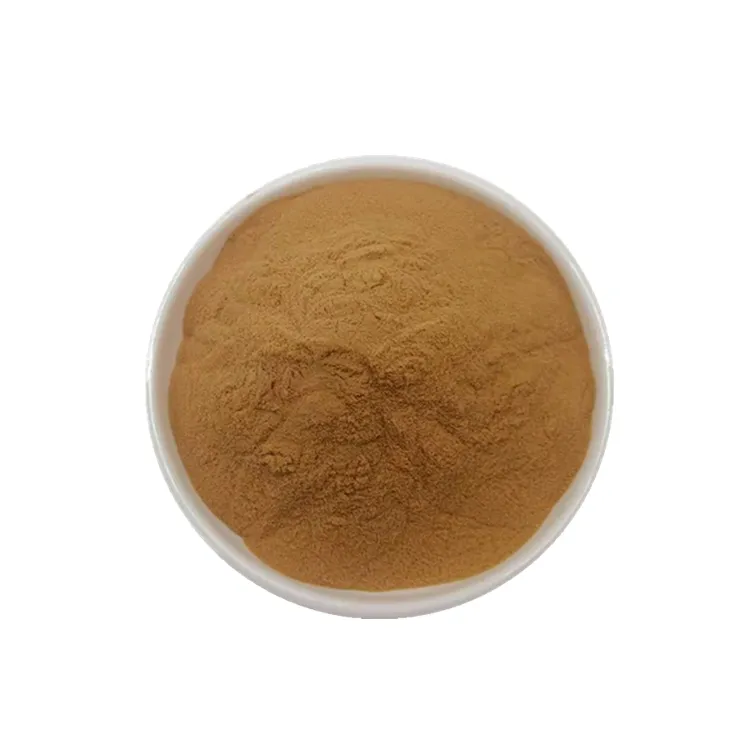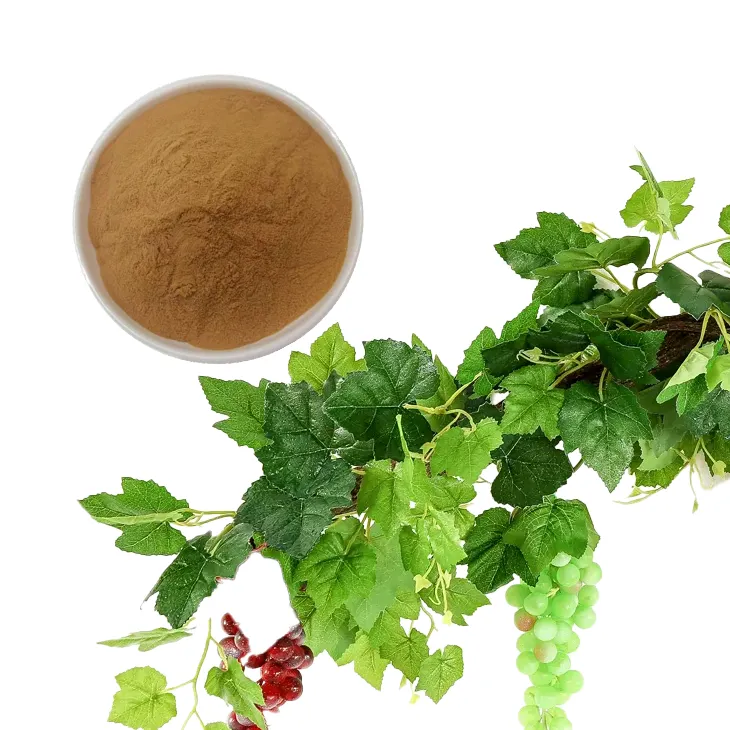- 0086-571-85302990
- sales@greenskybio.com
Grape Leaf Extract of the Best Quality.
2024-11-26

I. Introduction
Grape Leaf Extract has emerged as a significant natural extract with great promise. In recent years, it has attracted increasing attention from various fields, including nutrition, alternative medicine, and the cosmetics industry. The best - quality Grape Leaf Extract stands out due to its unique properties and potential benefits.

II. The Source: Selecting Grape Leaves
The selection of grape leaves for extraction is a meticulous process. It is not a random choice but rather a well - planned operation based on the knowledge of grapevine growth. Grape leaves are not all created equal when it comes to extraction. The optimal time for harvesting the leaves is a crucial factor.
1. The Right Time for Harvesting
Leaves that are harvested at the right time, when they are rich in bioactive compounds, are crucial. This timing often depends on the growth cycle of the grapevine. For example, during certain growth stages, the leaves may accumulate higher levels of flavonoids, polyphenols, and other beneficial substances. Harvesting too early or too late may result in a lower quality extract. Early harvesting may lead to incomplete development of the desired compounds, while late harvesting may cause some of the valuable components to degrade.
2. Grapevine Varieties
Another aspect to consider is the variety of the grapevine. Different grapevine varieties may have different leaf compositions. Some varieties may be more suitable for extraction due to their higher content of certain bioactive compounds. For instance, certain ancient or wild grapevine varieties have been found to have unique chemical profiles in their leaves that could potentially yield a more potent extract.

III. The Extraction Process
The extraction solvents and methods are carefully chosen to ensure the highest quality. This is a complex area that requires scientific knowledge and expertise.
1. Selection of Solvents
There are various solvents that can be used for extracting Grape Leaf Extract, such as ethanol, water, or a combination of both. Each solvent has its own advantages and disadvantages. Ethanol, for example, is a commonly used solvent as it can effectively dissolve many of the bioactive compounds in grape leaves. However, the use of ethanol also needs to be carefully regulated to ensure safety and compliance with regulations. Water - based extraction, on the other hand, is considered more environmentally friendly, but it may not be as effective in extracting certain hydrophobic compounds.
2. Extraction Methods
There are several extraction methods available, including maceration, percolation, and supercritical fluid extraction. Maceration involves soaking the grape leaves in the solvent for a period of time to allow the compounds to be dissolved. Percolation is a process where the solvent is continuously passed through the grape leaves to extract the desired substances. Supercritical fluid extraction, which uses a supercritical fluid (such as supercritical carbon dioxide) as the solvent, is a more advanced and environmentally friendly method. It can obtain a more pure and potent extract as it can selectively extract the target compounds while leaving behind unwanted impurities.

IV. Nutritional Composition
From a nutritional point of view, the best - quality grape leaf extract is a rich source of vitamins and minerals in addition to its unique phytochemicals.
1. Vitamins
Grape leaf extract contains various vitamins, such as vitamin C, vitamin E, and some of the B - vitamins. Vitamin C is an important antioxidant that can help protect cells from oxidative damage. Vitamin E also has antioxidant properties and is involved in maintaining the integrity of cell membranes. The B - vitamins play a role in energy metabolism and nerve function.
2. Minerals
The extract is also a source of minerals like potassium, calcium, and magnesium. Potassium is essential for maintaining proper heart function and fluid balance in the body. Calcium is well - known for its role in bone health, but it also has other functions such as muscle contraction and nerve transmission. Magnesium is involved in over 300 enzymatic reactions in the body and is important for energy production and muscle relaxation.
3. Phytochemicals
The phytochemicals in grape leaf extract are perhaps the most interesting aspect of its nutritional composition. Flavonoids, such as Quercetin and rutin, are among the most abundant phytochemicals. These flavonoids have antioxidant, anti - inflammatory, and anti - microbial properties. They can help reduce the risk of chronic diseases such as heart disease, cancer, and diabetes. Another group of phytochemicals in grape leaf extract is the phenolic acids, which also contribute to its antioxidant and anti - inflammatory activities.
V. Health Benefits
The best - quality grape leaf extract offers several potential health benefits, which have been the subject of numerous studies.
1. Digestive Health
These nutrients can contribute to overall well - being, such as improving digestion and enhancing nutrient absorption. Grape leaf extract may help stimulate the production of digestive enzymes, which can improve the breakdown and absorption of food. It may also have a prebiotic effect, promoting the growth of beneficial gut bacteria, which are important for a healthy digestive system.
2. Stress and Anxiety Relief
In the field of alternative medicine, it has been studied for its potential in relieving stress and anxiety. Some of the phytochemicals in grape leaf extract, such as certain flavonoids, may have a calming effect on the nervous system. They may interact with neurotransmitters in the brain to reduce feelings of stress and anxiety.
3. Neurodegenerative Disease Prevention
Its antioxidant properties also make it a candidate for preventing neurodegenerative diseases. Oxidative stress is believed to play a significant role in the development of neurodegenerative diseases such as Alzheimer's and Parkinson's. The antioxidants in grape leaf extract can help neutralize free radicals and reduce oxidative stress in the brain, potentially protecting neurons from damage.
VI. Applications in Different Industries
The best - quality grape leaf extract has a wide range of applications in different industries.
1. Food and Beverage Industry
In the food and beverage industry, grape leaf extract can be used as a natural flavor enhancer or a functional ingredient. It can be added to juices, teas, and other beverages to provide additional health benefits. It can also be used in the production of functional foods, such as energy bars or dietary supplements.
2. Cosmetics Industry
The antioxidant and anti - inflammatory properties of grape leaf extract make it a valuable ingredient in the cosmetics industry. It can be used in skin care products such as creams, lotions, and serums to protect the skin from oxidative damage and reduce inflammation. It may also help improve skin elasticity and reduce the signs of aging.
3. Pharmaceutical Industry
In the pharmaceutical industry, the potential health benefits of grape leaf extract are being explored for the development of new drugs or as a complementary therapy. However, more research is needed to fully understand its pharmacological effects and develop safe and effective formulations.
VII. Conclusion
Overall, the best - quality grape leaf extract is a valuable natural resource worthy of in - depth exploration. Its unique combination of bioactive compounds, nutritional value, and potential health benefits make it an interesting subject for further research. However, more studies are needed to fully understand its properties and applications. With the increasing demand for natural products in various industries, grape leaf extract has the potential to become an important ingredient in the future.
FAQ:
What are the key factors in obtaining the best - quality grape leaf extract?
The key factors include meticulous selection of grape leaves, which should be harvested at the right time when they are rich in bioactive compounds (usually related to the growth cycle of the grapevine). Also, careful choice of extraction solvents and methods is important. Environmentally friendly and efficient extraction methods can lead to a more pure and potent extract.
What nutritional benefits does the best - quality grape leaf extract offer?
The best - quality grape leaf extract is a rich source of vitamins and minerals along with its unique phytochemicals. These nutrients can contribute to overall well - being, for example, they can improve digestion and enhance nutrient absorption.
What potential does the best - quality grape leaf extract have in alternative medicine?
In alternative medicine, it has been studied for its potential in relieving stress and anxiety. Its antioxidant properties also make it a candidate for preventing neurodegenerative diseases.
How is the harvest time of grape leaves related to the quality of the extract?
The harvest time of grape leaves is crucial for the quality of the extract. Leaves should be harvested when they are rich in bioactive compounds, which is often related to the growth cycle of the grapevine. Harvesting at the right time ensures that the resulting extract has a higher quality.
Why are the extraction solvents and methods important for the best - quality grape leaf extract?
The extraction solvents and methods are important because they determine the purity and potency of the extract. Carefully choosing environmentally friendly and efficient extraction methods can obtain a more pure and potent extract.
Related literature
- The Composition and Benefits of Grape Leaf Extract"
- "Advances in Grape Leaf Extract: Quality and Applications"
- "Grape Leaf Extract: A Comprehensive Review of Its Quality and Therapeutic Potential"
- ▶ Hesperidin
- ▶ citrus bioflavonoids
- ▶ plant extract
- ▶ lycopene
- ▶ Diosmin
- ▶ Grape seed extract
- ▶ Sea buckthorn Juice Powder
- ▶ Beetroot powder
- ▶ Hops Extract
- ▶ Artichoke Extract
- ▶ Reishi mushroom extract
- ▶ Astaxanthin
- ▶ Green Tea Extract
- ▶ Curcumin Extract
- ▶ Horse Chestnut Extract
- ▶ Other Problems
- ▶ Boswellia Serrata Extract
- ▶ Resveratrol Extract
- ▶ Marigold Extract
- ▶ Grape Leaf Extract
- ▶ blog3
- ▶ blog4
-
Chinese Withania somnifera Extract Factory.
2024-11-26
-
中国松树皮提取物粉粉末供应商
2024-11-26
-
High - quality Marigold Extract Products.
2024-11-26
-
100% Pure Natural Mango - Flavored Powder.
2024-11-26
-
Sea buckthorn Juice Powder
2024-11-26
-
Okra Extract
2024-11-26
-
Stevia Extract
2024-11-26
-
Senna Leaf Extract
2024-11-26
-
Yam Extract
2024-11-26
-
Oyster Mushroom Extract Powder
2024-11-26
-
Green Tea Extract
2024-11-26
-
melatonin extract
2024-11-26
-
Mulberry Extract
2024-11-26
-
Phellodendron Extract
2024-11-26





















